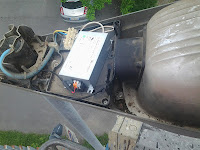What's in common between Vitamin A and LED ? This is what I read in a spanish website :
"The professor of the
University College of Optics at the Complutense says LED lights are
made up of rainbow longitude waves, and it is the blue part which
causes the problem.
“LED is fantastic
if there is adequate protection,” she explains. She also says using good
sunglasses with UV filter rays, and a healthy and varied diet rich in
Vitamin A – which comes from spinach and peppers – will protect
the eyes.
The Prince of Asturias
Scientific Investigation Prize winner in 2009 says Vitamin A has a
high concentration of visual pigments, known as 'maculars', which are
responsible for absorbing the harmful elements of light such as
short-wave blue and violet rays.
A human being's ability to
store these pigments reduces with age." OK, so the problem remains and the discussion will go on over and over again.. !
* * *
Cosa c'è in comune tra la vitamina A e il LED? Questo è ciò che ho letto in un sito spagnolo: "Il professore della University College di Ottica presso la Complutense sostiene che i LED sono costituiti da onde longitudinali che includono tutti i colori dell'arcobaleno, ed è la parte blu che causa problemi alla retina umana. "I LED sono fantastici se esiste una protezione adeguata", spiega. Dice anche che con buoni occhiali da sole con filtro ai raggi UV e una dieta sana e variata, ricca di vitamina A - per es.spinaci e peperoni - si ha un'ottima protezione per gli occhi. La vincitrice del premio de Il Principe delle Asturie Scientific Investigation nel 2009, dice che la vitamina A o "retinolo" ha un'alta concentrazione di pigmenti visivi responsabili dell' assorbimento degli elementi nocivi della luce, come i raggi blu e viola a onde corte.
La capacità di un essere umano di memorizzare questi pigmenti si riduce con l'età. " OK, quindi il problema rimane e la discussione continua..!
La capacità di un essere umano di memorizzare questi pigmenti si riduce con l'età. " OK, quindi il problema rimane e la discussione continua..!
Tks Ilja !






